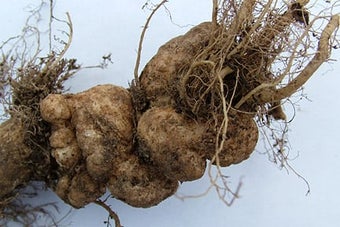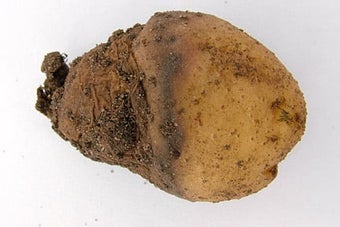
Quick facts
Common name - Common scab and powdery scab
Scientific name - Streptomyces spp. and Spongospora subterranea
Plants affected - Mainly potatoes
Main symptoms - Rough, scabby patches on tubers
Caused by - Filamentous bacteria and an organism closely related to the slime moulds.
Timing - Summer
What are potato scabs?
Common scab is caused by a number of different species of Streptomyces, and powdery scab by Spongospora subterranea. Both are pathogenic micro-organisms and cause rough, scabby patches. Scabs appear during summer and persist on harvested tubers throughout storage.
Common scab is most serious on potatoes, but also affects beetroot, radishes, swedes and turnips. Common scab is worse if soil conditions are dry when the potato tubers form.
Powdery scab is worse under wet conditions and also sometimes infects the roots of tomato plants.
Symptoms
You may see the following symptoms:
- Common scab: Raised, rough patches of skin on the surface
- Powdery scab: Irregular brown raised areas or depressions, often with papery margins, on the surface of tubers. These areas contain masses of dusty brown spores
Severe attacks of powdery scab can lead to massive distortion of tubers, reminiscent of wart disease caused by Synchytrium endobioticum, a serious but now very rare potato disease.

Control
Non-chemical control
- Select seed carefully and avoid planting seed potatoes that have visible signs of scab. Legislation controls the amount of infection allowed in seed, but low levels are permitted
- To control common scab, do not allow the soil to become dry during development. Raise organic matter levels to improve water retention. Water the developing crop if necessary, starting two to three weeks after plants emerge and continuing for about four weeks, applying 20 litres per sq m (4 gallons per sq yd)
- Common scab is worse on , so liming the soil to prevent club root of brassicas will predispose to common scab in potatoes. Apply lime after the potato course of the rotation
- Choose resistant cultivars. ‘Accent’, ‘Arran Pilot’, ‘Juliette’, ‘Golden Wonder’, ‘King Edward’, ‘Pentland Crown’ and ‘Pentland Javelin’ show some resistance to common scab. ‘Desiree’, ‘Hermes’, ‘King Edward’, ‘Pixie’ and ‘Sante’ show some resistance to powdery scab
- AHDB Potatoes produces the British Potato Variety Database, which lists pest and disease resistance on a one to nine scale for many cultivars and is a valuable guide to selection if any particular pest or disease is known to be a likely problem. For more information visit The British Potato Variety Database
Chemical control
There are no chemical controls available to gardeners for either disease.
Biology
Both organisms exist in the soil, either free-living (Streptomyces spp.) or as spores (S. subterranea). They invade the surfaces of potato tubers and the plant responds by growing corky scabs, which actually limit the spread.
Powdery scab is worse under wet conditions because its spores germinate to produce infective swimming spores that need water for infection. By contrast, severe attacks of common scab can occur if the soil is dry during early development.
Light attacks of both diseases are only superficial and do little to affect eating quality, but they are commercially important because cosmetic damage lowers the value of the crop. Severe attacks can lead to cracking of the skin and rotting of the tubers.
Very severe attacks, especially of the cankerous form of powdery scab, may be mistaken for infection by the serious disease known as potato wart. Wart is now very rare in the UK, but is notifiable and if it is suspected, the relevant plant health authority should be informed. Contact details can be found on the UK Plant Health Information Portal.




